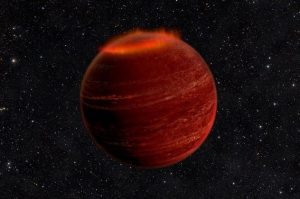 Travel
Travel  Travel
Travel  Creepy
Creepy 10 Haunted Places in Alabama
 History
History Top 10 Tragic Facts about England’s 9 Days Queen
 Food
Food 10 Weird Foods Inspired by Your Favorite Movies
 Religion
Religion 10 Mind-Blowing Claims and Messages Hidden in the Bible Code
 Facts
Facts 10 Things You Never Knew about the History of Gambling
 Weird Stuff
Weird Stuff 10 Cool and Creepy Facts about Collecting Tears
 Humans
Humans The Ten Most Lethal Gunslingers of the Old West
 Misconceptions
Misconceptions 10 Phony Myths and Urban Legends That Just Won’t Die
 History
History 10 Amazing Roman Epitaphs
 Travel
Travel Top 10 Religious Architectural Marvels
 Creepy
Creepy 10 Haunted Places in Alabama
 History
History Top 10 Tragic Facts about England’s 9 Days Queen
Who's Behind Listverse?

Jamie Frater
Head Editor
Jamie founded Listverse due to an insatiable desire to share fascinating, obscure, and bizarre facts. He has been a guest speaker on numerous national radio and television stations and is a five time published author.
More About Us Food
Food 10 Weird Foods Inspired by Your Favorite Movies
 Religion
Religion 10 Mind-Blowing Claims and Messages Hidden in the Bible Code
 Facts
Facts 10 Things You Never Knew about the History of Gambling
 Weird Stuff
Weird Stuff 10 Cool and Creepy Facts about Collecting Tears
 Humans
Humans The Ten Most Lethal Gunslingers of the Old West
 Misconceptions
Misconceptions 10 Phony Myths and Urban Legends That Just Won’t Die
 History
History 10 Amazing Roman Epitaphs
Top 10 Fascinating Facts from Recent Scientific Discoveries
It seems as though every day that a new and exciting discovery is made by scientists on Earth and in space, or when new research from past discoveries comes to light—all increasing our scientific knowledge. Please read on to get a taste of what our scientists are hard at work doing in their continuous quest to “wow” us with the science they know we can’t ever seem to get enough of…
Related: Top 10 Absurd Scientific Experiments And Discoveries
10 Huge Deep-Sea Mountain Range Discovered
The online science magazine ScienceNews.org recently reported that the number of mountains under our oceans has now doubled. According to scientists, satellites have located almost 20,000 seamounts that we weren’t aware of. Just like mountains on land, the height of underwater mountains is measured from their base to their peak.
In fact, the tallest peak on the planet isn’t Mount Everest; it’s Mauna Kea, a dormant volcano off the shores of Hawaii. The tallest mountain on Earth is more than 33,460 feet (10,200 meters) tall![1]
9 First Radiation Belt Outside the Solar System Discovered

Scientists have discovered a belt of radiation around another planet for the first time outside of our solar system, according to SciTechDaily.com. They also reported in Nature on the same day that a Jupiter-sized exoplanet, around 18 light years away, was found to be surrounded by a belt of energetic electrons. (FYI: a light year is a measurement of distance, not time, and is six trillion miles.)
As radiation moves, it emits radio waves that form into bands, and these bands can give clues to the shape of an object’s magnetic field, how it is made, and possibly whether or not it has moons. Scientists know that every planet with a global magnetic field forms radiation bands in our solar system. So by using their network of 39 radio telescopes around the planet, they created an Earth-sized radio telescope, which scientists used to zero in on the Jupiter-sized exoplanet with the not-so-catchy name of LSR J1835+3259, and discovered the radiation belt around it.[2]
8 1,100-Year-Old Breastplate Worn to Ward Off Evil
Discovered in the ruins of an ancient fortress in Bulgaria, an inscription on an 1,100-year-old breastplate could be one of the oldest known specimens of Cyrillic writing, according to an article published by LiveScience.com. Scientists report unearthing a finger-shaped piece of lead with text that refers to two friends named Dimitar and Pavel, worn to ward off evil and keep the wearer out of danger. Scientists do not know who these two people were but suspect they were related to each other.
Dating back to the days of Tsar Simeon I, also known as Simeon the Great, the ruler of the Bulgarian Empire, the inscription was probably made during this time around AD 893 and 927. The Cyrillic system of writing was used in Russia and other Eurasian nations and was developed during the Middle Ages.[3]
7 Perfectly Preserved 7,000-Year-Old Skeleton Located

Ancient-Origins.net reported that an extremely well-preserved 7,000-year-old skeleton found in the fetal position was recently excavated by archaeologists in Poland. The ancient skeleton discovered in loosely packed dirt contained a non-acidic chemical component that naturally preserved the bones, along with a small amount of pottery.
An archaeologist working on the dig said, “No one predicted that we would hit prehistoric objects.” Discovered near the city of Kraków during renovations of a town square in Słomniki, there were fragments of flint found along with other artifacts, but many were damaged due to the work of heavy equipment in the area. The investigation is ongoing.[4]
6 Mysterious White Powder Found in 3,000-Year-Old Armenian Ruin

Inside an ancient 3,000-year-old Armenian ruin, a weird powdery, white substance was found that was not what scientists first thought it was. As it turned out, the mystery powder they found inside the ruins was a dream come true for historians of the art of baking since they were piles of flour. A team of Polish-Armenian archaeologists made the find last fall, and the results are just now being released. After analyzing the powder and discovering what it was, they realized they had uncovered an ancient bakery since they had also located several large ovens.
Chemical analysis showed that the powder was wheat flour used to make bread. The scientists estimated that about 3.5 tons (3.2 metric tons) of flour would have fit inside the 82-square-foot (25-square-meter) structure. It was made from double rows of 18 wood columns, supporting a roof made from reeds, and held up with wooden beams. Scientists estimate that the bakery operated around the 11th and 9th centuries BC.[5]
5 Massive Cavern Under Antarctic Glacier Teeming with Life
According to LiveScience, it is very hard to see that a glacier called the Ice Stream in West Antarctica has a coast. Situated just 500 miles (800 kilometers) from the South Pole, all that can be seen is a flat sheet of ice, which is about 2,300 feet (700 meters) thick and extends hundreds of miles from shore. The sun reflects off the ice so intensely during the Antarctic summer that one’s nostrils can be sunburned.
Although hard to imagine, behind this mass of ice, there is a mud-choked tidal marsh where a brook winds its way to the ocean. This terrain has been hidden until recently, and its existence was only detected due to erratic seismic and radar readings. In 2021, a team of scientists from New Zealand drilled a hole through the ice and dropped a camera down to see what they could see.
They had a suspicion that there was a huge, cavernous depression in the ice as tall as a skyscraper. They hoped to be able to electronically peer into it, and they did. After their initial excitement, the scientists took core samples and discovered it teeming with microscopic fossils of sea sponges, marine diatoms, and, oddly enough, pollen grains of southern beech trees.[6]
4 Humongous, 100-Foot-Long Titanosaurus Dug Up in Argentina
The remains of a gigantic long-necked dinosaur were excavated in Argentina that measure 100 feet (30 meters) in length. Estimated to be around 90 million years old, the remains were determined to be a titanosaur—the biggest of the long-necked dinosaurs. The bones of the beast were so heavy that their transportation to Buenos Aires caused an accident on the way due to the truck’s load shifting. Fortunately, nobody was seriously hurt.
In other news, paleontologists excavated the fossil of a C. diripienda strewn about the Patagonian hillside, including bones from its hips, forelimbs, and hind legs. They were so heavy that workers had to move them inch by inch to get them out of the field. The largest dinosaur found to date is most likely the 150-million-year-old supersaurus, excavated in the American southwest, which measured 128 feet (39 meters) in length![7]
3 Piece of Halley’s Comet Goes Through Family’s Roof
According to an article published by IFLscience.com, a family got a big surprise when a meteorite smashed through the roof of their Hopewell, New Jersey, home. According to police reports, a 4-by-6-inch (10-by-15-centimeter) object that was obviously natural and not just space junk had pierced the roof of their home and ended up on the owner’s living room floor without injuring anyone.
Meteor showers called the Eta Aquarids are caused by debris from the passing of Halley’s comet, and even though it’s been 37 years since it last came through the solar system, debris in its long tail trails behind it. Every May and October, Earth passes through this debris trail, causing the Eta Aquarids meteor showers. Most of the debris is the size of grains of sand, but occasionally, a piece big enough makes it through the atmosphere and makes it to the surface, as in the New Jersey case. Since having time to examine the space rock, scientists think the chances are good that the object is a piece of debris from the Eta Aquarids meteor shower, making it part of the famous comet.[8]
2 Killer Wales Are Sinking Boats and Teaching Others to Do It
Talk about creepy. The New York Times published an article reporting witness testimony on how killer whales are sinking boats in Europe and teaching other whales how to join in on the fun. Since 2020, witnesses have been reporting dozens of orca attacks in the Strait of Gibraltar involving the huge animals, sometimes causing serious damage by actually focusing on the rudder of a craft. Scientists feel they’ve come up with the reason—a single orca was somehow traumatized enough to trigger the strange behavior and spread it to the other whales in the pod.
As evidence, the scientists point to an orca in the same pod they call White Gladis, who was somehow injured in a collision with a ship or was caught in a net. But regardless, the stress sent the animal into a fit, and it started attacking boats. Scientists theorize that this one whale’s aggression was transferred to the entire pod, causing them to go on their boat-bashing rampages.[9]
1 “Brain-Eating” Amoeba Hits Northern U.S. States
A “brain-eating” amoeba has invaded the northeastern United States and is starting to infect more victims. These deadly brain-eating amoeba attacks normally occur in southern states. Still, recent climate change has allowed the deadly single-celled animals to increase their range north into states such as Minnesota, Ohio, Iowa, and Indiana. According to the CDC, the animal’s scientific name is Naegleria fowleri, which typically thrives in soil that gets a steady supply of fresh warm water, can live in hot water tanks and plumbing inside homes.
They get their “brain-eating” moniker since they can, on rare occasions, make it to the human spinal cord and brain, but since the usual route is through drinking water, the animals are quickly killed by stomach acids. N. fowleri cannot spread between humans either. Although also rare, a brain-eating bug can cause primary amebic meningoencephalitis (PAM), an extremely rare infection that is usually lethal.[10]








